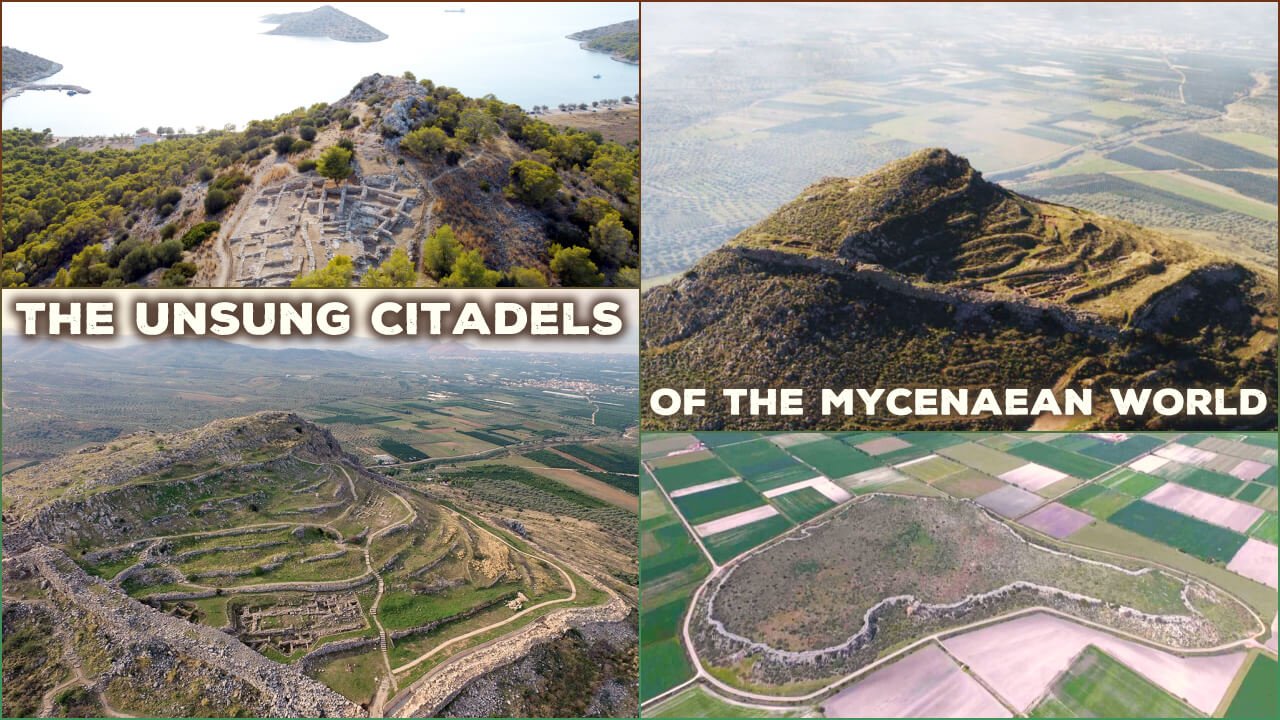BY
DIMOSTHENIS VASILOUDIS
Silent Sentinels: The Unsung Citadels of the Mycenaean World
CONTENTS
-
The Mycenaean Acropolis of Midea
-
The Fortified Acropolis of Gla
-
The Mycenaean Palace of Ayios Vasileios Hill near Sparta
-
The Maritime Settlement of Korphos-Kalamianos
-
The Mycenaean Settlement of Pellana in Laconia, The City Known to Mycenaeans as “Lakedaemon”
-
The Acropolis of Palaiokastro (Homeric Phiri) and its Enigmatic Necromancer
-
The Mycenaean Palace Complex of Thebes
-
Mycenaean Acropolis of Kanakia, Palace of Ajax of Telamon
-
The Mycenaean Complex Of Iklaina
-
The Acropolis of Aigeira, What Mycenaeans Called “Hyperisia”
-
The Mycenaean Princedom of Orne in Crete
-
Mycenaean Settlement and Palace in Iolkos, Thessaly
-
The Mycenaean Acropolis at Koukounaries, Paros
The Mycenaean civilization, a Late Bronze Age culture that existed in Greece from around 1600 to 1100 BC, known for its golden masks, opulent palaces, and epic tales, has left an indelible mark on the history of Europe. Renowned for their architectural wonders, the Mycenaeans erected grand palaces and fortifications throughout the Greek mainland. While most people are familiar with famous sites like Mycenae, Tiryns, and Pylos, there are many lesser-known acropolis-citadels that offer a deeper insight into this fascinating civilization. Let’s uncover some of these hidden gems!
1. the mycenaean acropolis of Midea

Located in the Argolid region of the Peloponnese, Midea, though smaller than its famed neighbors Mycenae and Tiryns, stands out with its impressive Cyclopean walls. Historians believe that Midea was not just a military outpost but also an essential religious center. The site’s strategic position on a hilltop provided a panoramic view of the surrounding plains, making it a vital lookout and defense point.
The Acropolis of Midea
was first excavated in 1939 and later underwent a systematic excavation in 1983. Located on a strategic hill, it was a significant center during the Mycenaean period. The site, which has been inhabited since the Neolithic period, flourished, especially during the Bronze Age.


However, a powerful earthquake in the 13th century BC caused significant damage. The site had strong fortification walls, two main gates (East and West), and the remains of various buildings, including a “megaron” and other structures. Recent excavations have unveiled pottery, clay figurines, metal vessels, tools, jewelry, and inscriptions in the Linear B script.
2. tHE FORTIFIED ACROPOLIS OF Gla

Set apart on a plateau surrounded by the waters of Lake Kopais in Boeotia,
Gla
boasts the most extensive Mycenaean fortifications. Although it was considerably large, surpassing the size of contemporary Mycenae or Tiryns by over ten times, it does not feature in the Iliad.
The region was an agricultural goldmine, and Gla controlled an intricate drainage system that converted marshy grounds into fertile farmlands, underscoring its economic and strategic significance. It is located on a limestone rock island in what was once the former Lake Kopais. The lake, once the largest in southern Greece, was drained using an intricate system of dams and canals, turning the area into a fertile plain. This drainage likely coincided with Gla’s construction.


Interestingly, Gla is the largest of all Mycenaean fortifications, yet its function and significance are still debated among scholars. The walls included four gates, a notable amount for Mycenaean defenses, leading to the idea that it might have been more of a military base than a palatial complex. Some suggest that it may have been an administrative or trading center due to its strategic location.
Inside Gla, the predominant feature is an L-shaped edifice often referred to as a “palace.” However, its classification as a palace is debated due to the absence of several standard palace features. Other structures in the vicinity, like the so-called “agora,” remain ambiguous in purpose.
3. The MYCENAEAN PALACE OF Ayios Vasileios hill near sparta

Ayios Vasileios, located near Sparta in the Peloponnese, was only recently recognized as a
major Mycenaean center
. Excavations that began in the early 21st century revealed an impressive palatial complex and numerous valuable artifacts. Some of the finds, including Linear B tablets (an early script used by the Mycenaeans), have provided new insights into the administration and socio-political dynamics of the region. These tablets provide insights into economic activities, religious practices, and even the names of deities worshipped during that era.
The most important discoveries at this site include an old Mycenaean palace covering 35 acres on the hill. This palace had big buildings around a central courtyard with paintings on the walls. These buildings were rebuilt after an earlier set was destroyed by fire around the late 15th or early 14th century BC.
4. tHE MARITIME SETTLEMENT OF Korphos-Kalamianos
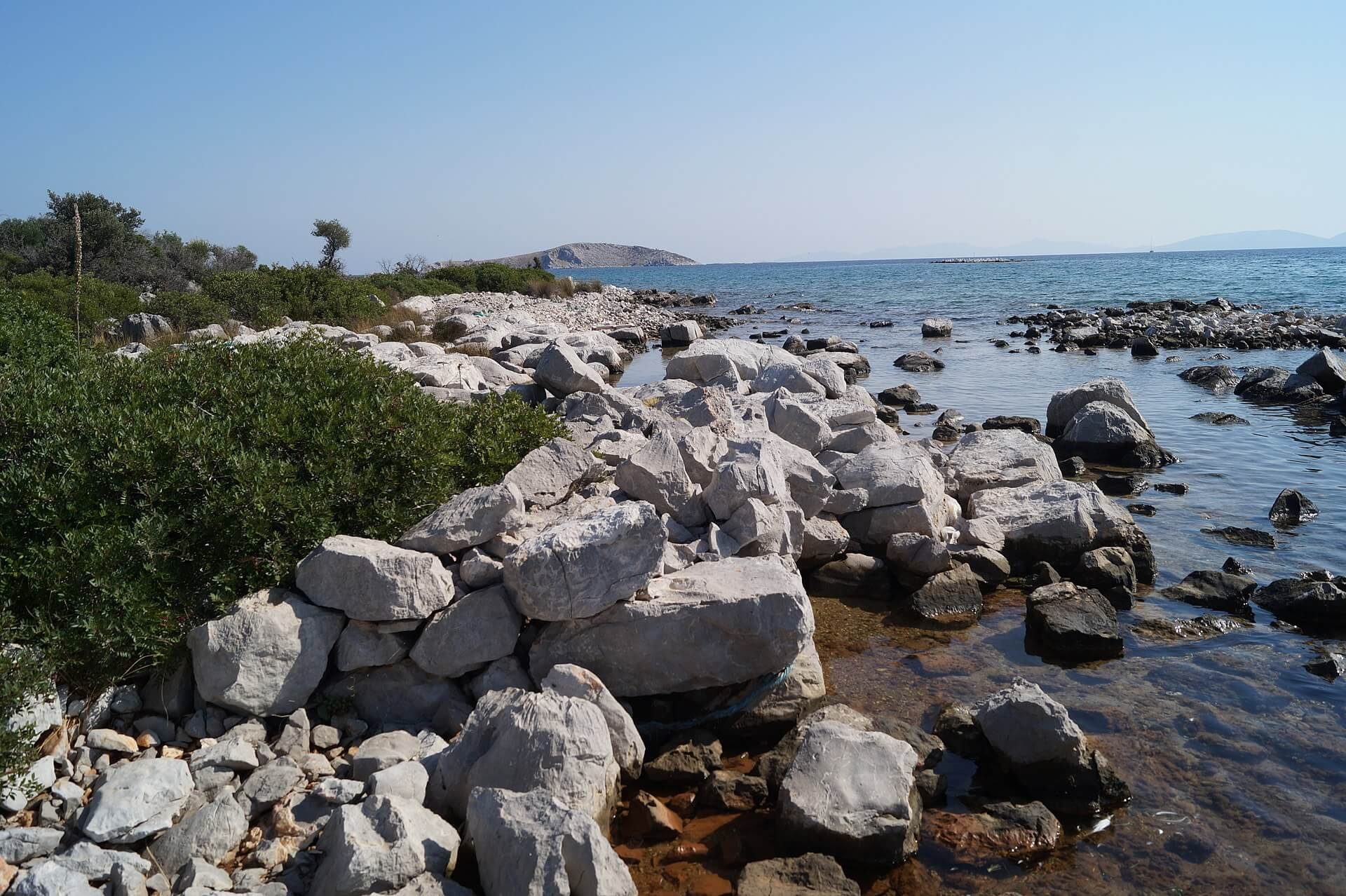
Occupying a unique position on the Saronic Gulf in the region of Corinth, Korphos-Kalamianos was a
maritime town with fortifications
hinting at its defensive nature. Its ruins suggest it may have been a key trade link connecting central Greece with the broader Aegean world, facilitating the exchange of goods and ideas.
Part of this settlement is now underwater. In 2009, experts did underwater research to understand the old coastline, how big the settlement was, and if there was an ancient harbor underwater. They found rows of beach rock with old pottery pieces from around 3,000 to 2,000 years ago. This shows where the coastline used to be. More studies will be done to see if their findings are right and to understand why this part of the land went underwater.
Unlike other Mycenaean citadels that are often situated on elevated terrain, Korphos-Kalamianos is relatively flat. This unique characteristic has led some archaeologists to believe that it was primarily a maritime center. The discoveries of extensive storage facilities and workshops suggest that it might have been a hub for trade and production.
5. The mycenaean settlement of pellana ιν laconia, the city known to mycenaeans as “lakedaemon”

Photo by
Real Sparta
Pellana is a village near Sparta in Laconia. It’s an old place with ruins and was important for the Spartans. There’s a hill called Paleokastro, which has an old wall around it from a long time ago. This hill has many old pieces of pottery and stuff, and people think there was an important Mycenaean palace there too. Set majestically on a hill, Paleokastro is a testimony to Mycenaean urban planning. Its fortifications and building foundations suggest a bustling city life. The vantage point also provided strategic advantages, keeping an eye on both the Eurotas valley and the Laconian coastline. The site has revealed traces of Mycenaean architecture, pottery, and other artifacts, suggesting its once-thriving presence in the Mycenaean network.
Some researchers found three important places with old Mycenaean things around Pellana. One of them is a cemetery with big stone tombs. Two of these tombs were checked in 1926. One tomb had only broken pottery. The other tomb had graves inside, but they were messed up and looted. There was also a special amber button found outside one of the tombs, which came from a faraway place called the Baltic.



Another exciting thing they found is a big old road that goes up to the hill. This road is one of the best-preserved Mycenaean roads in Greece, and it might have led to a king’s house or some other important building on the hill.
Some people think Pellana is the old city called Lakedaemon from Mycenaean times. They’ve been digging there for 15 years, trying to find a palace that belonged to some famous kings from old stories. They haven’t found the palace yet, but they found other amazing things that show Pellana was a powerful place long ago.
6. The Acropolis of Palaiokastro (homeric phiri) and its Enigmatic Necromancer
The Mycenaean acropolis of Palaiokastro, located in the province of Gortynia, Arcadia, stands prominently on a distinctive conical hill adjacent to the Alpheios riverbank. This ancient site has been suggested by many researchers to be synonymous with the Homeric city of Phiri. The surrounding area boasts an extensive Mycenaean cemetery, which, with 500 tombs, is the largest of its kind that has been excavated to date. The initial discoveries of tombs in 1955 by Ioannis Pisimisis paved the way for more comprehensive excavations led by Theodoros Spyropoulos in 1979, revealing around 100 intricately carved tombs of diverse designs, from vaulted to pit-shaped.
Within this expansive cemetery lies an extraordinary discovery: a construction believed to have functioned as a Necromancer during the Mycenaean era, between 1600 and 1200 BCE. This necromantic site holds the unique distinction of being the sole known Mycenaean-era necromancer and is hailed as the oldest in Greece. Its significance extends beyond mere antiquity; it’s believed to have parallels with the necromancy described in the Λ’ Rhapsody
Nekyia
of the Odyssey. Archaeological evidence indicates that this site served as a major religious epicenter for a staggering 3,000 years, underscoring its immense cultural and historical importance. Notably, the invaluable artifacts unearthed from the cemetery can now be admired at the Tripoli Museum.
7. The Mycenaean Palace Complex of thebes

The ancient heart of modern-day Thebes reveals a tapestry of the city’s glorious past, dating back to the 13th century BC. The centerpiece is the grand Mycenaean Palace, also known as Kadmeion. Decked with intricate wall paintings, the palace was an archive of history with its clay tablets written in Linear B. But the flames of 1200 BC consumed this treasure, leaving behind tales of its grandeur.
The Mycenaean legacy of Thebes
is ensconced in its palace ruins and a treasure trove of Linear B tablets. These tablets highlight Thebes’ role as a formidable administrative and economic center. The site’s longevity is noteworthy, surviving from the Mycenaean era into the classical age, marking it as a crucial epicenter of culture and power. Diving into this vast archaeological landscape, we catch a fleeting yet vivid glimpse of Mycenaean Thebes in all its grandeur and significance.
Inside this vast palace complex:
The Academy:
Once a bustling hub, it was here that master craftsmen transformed materials, some sourced from as far as Afghanistan, into exquisite pieces of art and jewelry.
Treasure Room:
Living up to its name, this room was a vault, safeguarding precious items from gold jewelry to unique seals originating from different ancient cultures.
Armory:
This annex, found in the acropolis’ eastern part, wasn’t just a storage for weapons. It was also where the palace’s economic heartbeat thumped, with records meticulously kept on clay tablets.
Wool Processing Workshop:
More than just a workshop, this segment was an economic hub. In its heart, wool was processed, treated, and then recorded for distribution within and beyond Thebes.
Residences at 3 Evridikis Street:
These were no ordinary homes. Their luxurious nature and their position at the acropolis’ peak hint at their administrative significance in the palace’s hierarchy.
Goods Receiving Area:
Serving as Thebes’ ancient customs checkpoint, this area on the eastern side was where all incoming goods to the citadel were inspected and recorded. Artifacts unearthed here, from pottery to sealings, paint a picture of grand banquets and ceremonies.
8. Mycenaean Acropolis of Kanakia, Palace of Ajax of Telamon

On Salamis Island, the Kanakia site tells tales of the Mycenaeans’ maritime prowess. With evidence of fortifications, buildings, and a possible harbor, Kanakia seems to have been an essential naval base, ensuring control over the Saronic Gulf’s waters and facilitating trade routes. The Mycenaean capital of Salamis had a palace that belonged to Ajax the Great, a famous character from the Iliad.
This palace and other buildings from that time were discovered in Kanakia, Salamis, by a university excavation led by Mr. Giannos Lolos. The Kanakia acropolis is one of the oldest sites in Salamis, with a history that goes back to the Late Neolithic period (around 4,000 years ago).
The most important discoveries at this site include big buildings that were likely controlled by powerful rulers of that time. Unique to this palace is the presence of two throne rooms; this is the only Mycenaean palace where such a feature has been found. Besides the palace, researchers found a big industrial area with workshops and storage rooms. They found pottery, tools, and an especially rare copper plate that had a seal of Pharaoh Ramses the Second, a famous Egyptian king.
This acropolis is thought to be the original capital city of Salamis, mentioned in old writings. It was likely the center of a big maritime kingdom and the birthplace of other important cities, like Salamis in Cyprus.
9. the Mycenaean Complex Of Iklaina
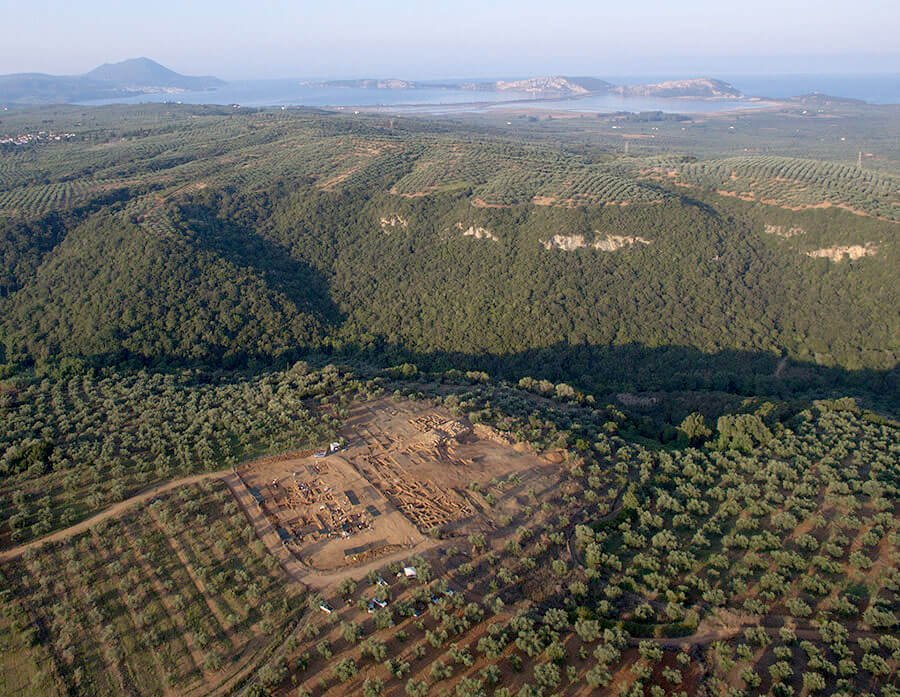
Located a mere 10 kilometers away from Nestor’s Palace in the Messenia region of the Peloponnese is the ancient city of Iklaina. Overlooking the bay where a significant naval victory occurred during the Battle of Navarino in 1827, this city, replete with a palace, administrative buildings, streets, and public squares, seems out of place among the olive trees. The city’s advanced infrastructure and luxurious palace were secured behind immense cyclopean walls. Much of what we know of this once-grand city is thanks to the
archaeological endeavors led by Michael Cosmopoulos
of the University of Missouri-St. Louis. His excavations uncovered invaluable artifacts, providing insights into how this city might have functioned as
one of the earliest federal states in the Western world
.
Iklaina’s significance in history is underscored by its mention in Homer’s “The Iliad,” a mention that occurred five centuries after the city’s destruction. Flourishing concurrently with the Palace of Nestor between 1500 and 1250 BC, the excavations at Iklaina, funded by various international institutions, started in 1999. Two decades of work have unveiled that the city was divided into distinct sections: administrative, residential, and manufacturing, indicating a sophisticated socioeconomic framework. Within the administrative area, a massive platform that possibly supported multi-story structures was found, along with mural fragments, well-preserved streets, squares, and other structures. The residential area boasted small villas and an impressively advanced central sewage system.
One of the most remarkable discoveries was the Linear B tablet’s clay fragment,
predating any other such tablet
and confirming Iklaina’s status as an independent state. By 1200 BC, however, Iklaina’s prominence declined as it was occupied and reduced to a manufacturing hub by the ruler of Nestor’s Palace. For modern scholars, Iklaina serves as a lens into the genesis of states in mainland Greece and, by extension, Western civilization.
10. the acropolis of Aigeira, what mycenaeans called “hyperisia”

Offering breathtaking views of the Corinthian Gulf, Aigeira’s location on a plateau in the northern Peloponnese speaks to its strategic significance. Along with remnants of buildings and fortifications, Aigeira may have served as a watchpoint against potential invasions and a nexus for overland trade.
The
Austrian Archaeological Institute
has been excavating the acropolis of Aigeira in the Northern Peloponnese since 1975, revealing vital insights into its ancient history. These excavations have uncovered the Premycenaean settlement (from the 5th to 3rd millennium BC) and the postpalatial Mycenaean settlement from the 12th century BC. The archaeological findings highlight house complexes equipped for storage, production, and feasting, pointing to the high social standing of the residents. A significant discovery was a cult room, further testifying to the importance of the inhabitants. Moreover, a fortification wall built during its later phase demarcates the acropolis from the lower terraces, indicating its significance in the broader settlement area.

Aigeira, located on the north coast of the Peloponnese, underwent intensive archaeological exploration between 1975 and 1980. The site, elevated at around 414 meters above sea level, displayed evidence of human habitation dating back to the Neolithic period. The oldest identifiable layers correspond to the Early Helladic periods, stretching from 4500 to 1600 BC. The Mycenaean phase, distinguished by specific pottery styles, is dated to the 12th century BC.
The excavations revealed detailed insights into life during that period, including a half-timbered house, terracotta figurines, bronze knives, pottery kilns, and a potential bronze workshop. By the advanced phase of the Mycenaean period, significant architectural changes occurred, with a prominent multi-roomed house surrounded by a fortification wall coming into existence. This fortified settlement persisted until the end of the Mycenaean period, as suggested by the architectural remnants and pottery styles.
11. the mycenaean princedom of orne in crete

The
recent archaeological excavation
in Crete has unearthed the Mycenaean citadel of Orne, positioned as the largest acropolis on the island, near the villages of Orne, Krya Vrysi, and Melampes. This significant dig, during its third phase in the Kastelos area, has revealed significant findings of immense archaeological value, spanning an expansive 55 acres, thereby establishing its stature as the most extensive Acropolis in Crete.
Situated 540 meters above sea level, the Kastelos citadel dates back to 1200 BC and boasts a stunning and well-organized residential layout in a breathtakingly beautiful locale. Apart from being naturally fortified on the west, the citadel is well protected from other sides, nestled within an untouched landscape, maintaining its natural charm.
Under the watchful eyes of the supervising archaeologist, Mr. Manos Papadakis, the site has been identified as one of the paramount archaeological landmarks of the Mycenaean era, covering an impressive 55 acres and standing as a testament to the architectural prowess of the period. The intricate urban planning showcases cobbled streets, large tiled rooms, and vast communal spaces, all revealing the sophisticated organization of the citadel. Notably, structures for storage, laboratories, and a metallurgy workshop, especially designed for producing bronze spears, have been uncovered.


Additionally, signs of places of worship have also been indicated by various figurines found on-site. The architectural marvel of this citadel is further highlighted by the optimal utilization of the hilly terrain, suggesting a significant population residing in the area. However, traces of an unfortunate fire, likely following an earthquake, signal the citadel’s eventual demise, leaving behind remnants of its rich history and artifacts. Mr. Papadakis particularly highlighted the vast rooms and substantial fortification walls, indicating a strategic shift of inhabitants from the coastlines to the elevated terrains.
12. Mycenaean Settlement and Palace in Iolkos, THESSALY

Photo by
Dimosthenis Vasiloudis
While famous for its association with the legend of
Jason and the Argonauts
, Iolkos, near modern Volos, was no mere myth. Recent excavations have unearthed palatial structures, suggesting it was a significant Mycenaean center, with the port possibly playing a role in wide-reaching maritime explorations and trade. While it’s challenging
to draw direct connections between the archaeological remains at Dimini and the Homeric or post-Homeric tales
, the prominence of Iolkos in Greek myth indicates its significance in the ancient Greek consciousness.
The ancient site of Iolkos, located near the modern village of Dimini in Thessaly, is an archaeological location closely associated with the Mycenaean civilization. This settlement dates back to the Late Bronze Age, and while it may not be as famous as Mycenae or Tiryns, it has produced valuable insights into the nature of the Mycenaean presence in Thessaly.
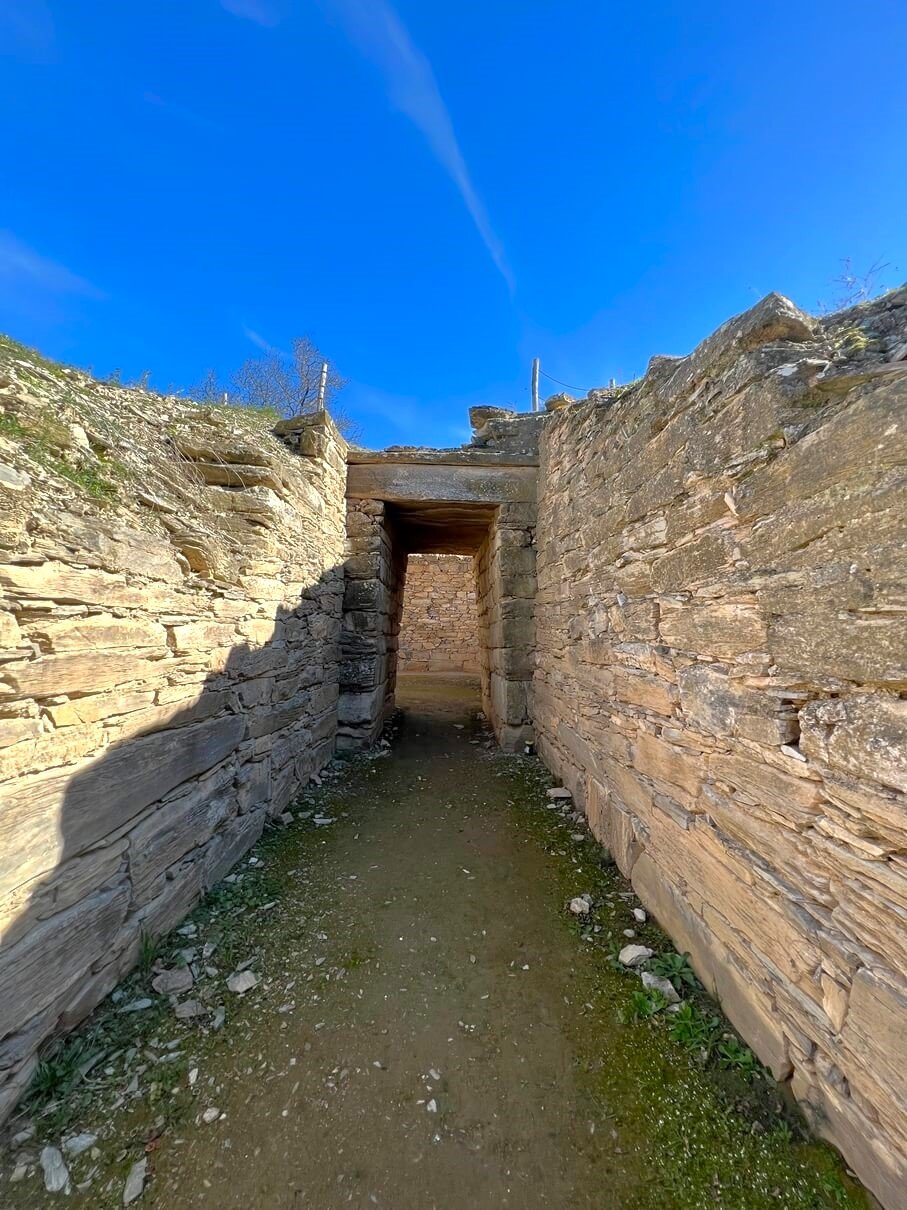

Excavations at
Dimini
have revealed a significant Mycenaean settlement that thrived between the 15th and 13th centuries BC. Among the most remarkable finds is a Mycenaean palace complex, with its characteristic Megaron—a large rectangular hall that is central to Mycenaean palatial architecture. This palace at Dimini has often been considered a counterpart to the better-known palatial structures found in southern Greece. Apart from the architectural remains, several Linear B tablets, the script used by the Mycenaeans, were found, indicating the presence of an administrative center.
The architectural structures at Dimini are quite characteristic of the Mycenaean era. The palace complex, with its Megaron, is a testament to the socio-political significance of the site. The layout shows a complex plan with rooms for storage, workshops, and ceremonial functions. Like other Mycenaean palaces, the one at Dimini would have been the residence of a local ruler, or
wanax
, and it would have served as the political, economic, and religious hub of the surrounding region.

Photo by
Dimosthenis Vasiloudis
Geographically, Iolkos’s position in Thessaly provided a critical link between the more developed Mycenaean centers of the Peloponnese to the south and the northern regions of the Greek mainland. Its proximity to the Aegean Sea made it a potential hub for trade and communication. The presence of the palace complex suggests that it was a significant administrative and possibly maritime center during the Late Bronze Age.
13. The Mycenaean Acropolis at Koukounaries, paros
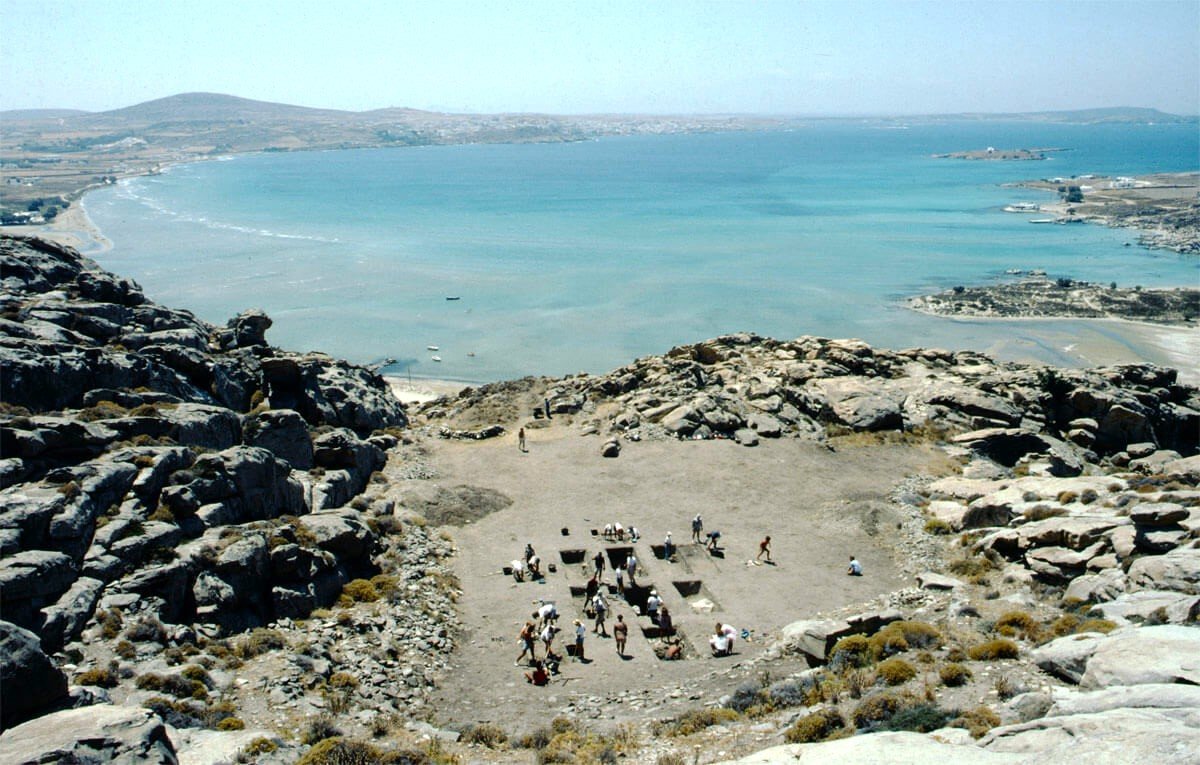
The
Koukounaria acropolis
can be found in Naoussa Bay, towards the northern part of Paros. Nestled amidst the unique granite structures in Paros’s Koukounaries region, archaeologists unearthed a Mycenaean community and a corresponding citadel.
This Mycenaean presence aligns with Paros’ myths involving Hercules. Experts believe that this settlement met its end through a devastating fire and remained uninhabited for some time.
In the early 12th century BC, the hill evolved into a fortified stronghold and became the residence of a Mycenaean leader. This transformation was led by Mycenaean refugees who migrated to Paros following the fall of the Mycenaean palaces on mainland Greece around 1200 BC. An affluent ruling complex was identified at its peak. A massive fire around 1150 BC razed the citadel, but it saw rapid habitation shortly after, as evidenced by relics from the later stages of the Mycenaean IIIG era and the early Protogeometric phase. As the Iron Age dawned, this citadel emerged as a significant living hub.


These almost unknown Mycenaean acropolis-citadels offer a glimpse into the diverse nature of Mycenaean settlements and the extent of their influence across ancient Greece. While they may not be as renowned as Mycenae or Tiryns, their archaeological value is undeniable. Exploring these hidden sites allows us to piece together a more comprehensive picture of the Mycenaean world and its remarkable civilization.
